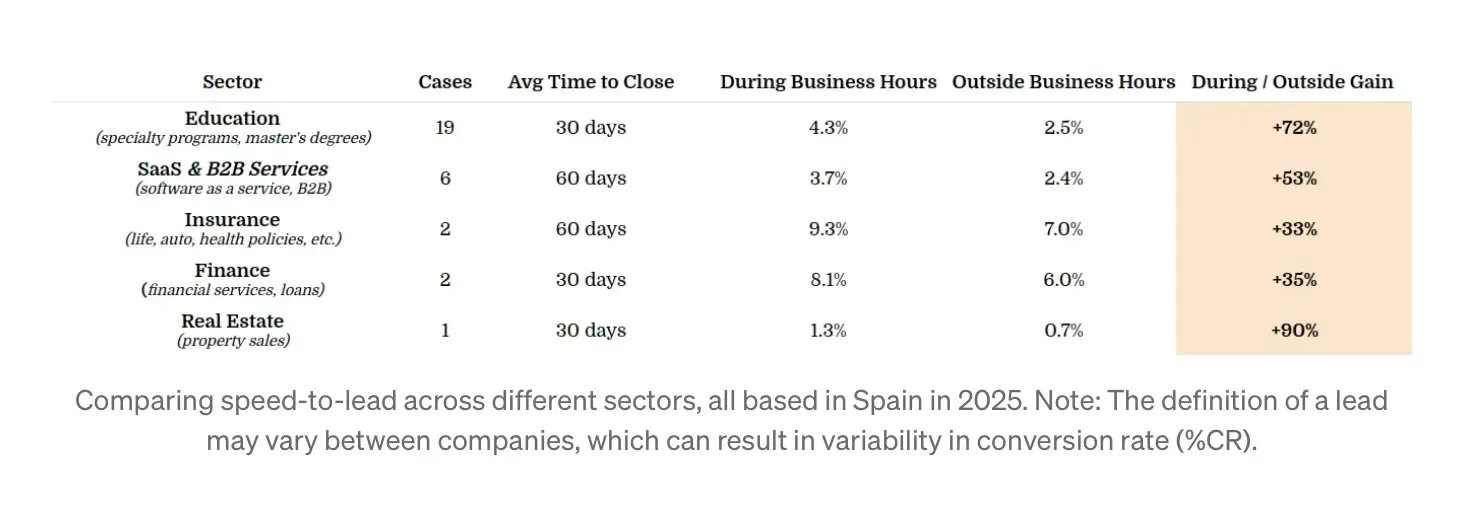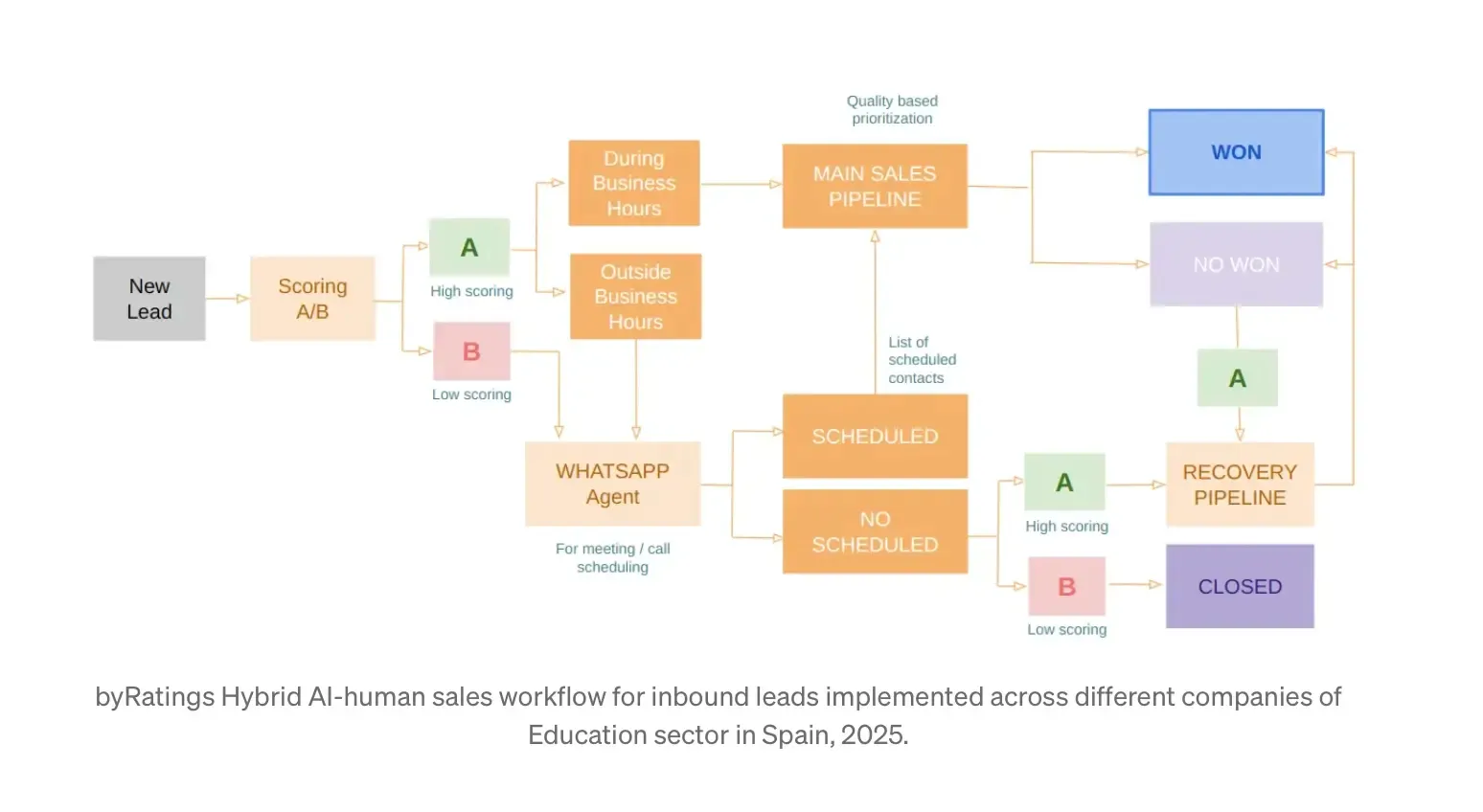I’ve spent years working with companies from a wide range of sectors: business schools and training academies, software startups, car dealerships, insurance providers, and financial institutions.
Though the industries and products differed, they all operated with naturally long sales cycles, often extending beyond 30 days. In theory, that gave them time to nurture the client. In practice, there was a weak link that repeated over and over again: leads came in, and no one called them right away.
It was constant. Someone filled out a form on a Wednesday at 7:43 p.m., requesting information about a master’s program, an insurance quote, or a loan. The company called them… the next day. Or two days later. By the time they made contact, the lead had typically cooled down or lost interest altogether.
I wanted to back up what I suspected with data: that “speed-to-lead” — the time between a lead being generated and someone calling them — was critical. But when I opened up the CRMs, I was shocked: most of my clients weren’t even tracking the timestamp of the first actual call. The most essential data point didn’t exist.
So I thought of a workaround: what if we simply compared the performance of leads who came in during business hours versus those who came in after hours? What would we find?
This turned out to be a solid proxy for commercial response behavior. Leads generated during business hours are, in principle, called more quickly — even if not instantly — because sales teams tend to prioritize by lead recency.
The results were chillingly clear, and I found two instances of 40%:

- More than 40% of the leads came in outside business hours — 14% during the weekend and 28% on weekdays outside of business hours.
- Their conversion rate dropped by nearly 40% (from 8% to 5%) when no one was available to respond promptly.
This finding was perfectly aligned with what Forbes had already published “The Lead Conversion Gap Every Company Struggles With” (2020):
40% of leads are generated outside regular business hours
The same article cites research from Harvard Business Review showing that failing to contact leads within the first few minutes significantly impacts conversion rates:
Leads are 21× more likely to purchase when contacted within five minutes of inquiry.
And yet, many companies continue to admit — often with a resigned shrug — that they simply don’t have the means to address it. The challenge is nothing new. It just hasn’t been solved.
There was no need for an advanced analytics audit. The problem had always been there — in plain sight — but no one had thought to measure it.
What Happened When We Looked Across Sectors
I wanted to take it further. Was this phenomenon unique to certain sectors? Or was it universal?
I reviewed data from 30 companies I worked closely with in Q1 2025 — primarily in Education, with meaningful representation from B2B Services and a handful from other sectors— and a clear pattern emerged across industries:
 It didn’t matter whether the product was a property or a master’s degree, an insurance policy or a SaaS. If the lead was contacted quickly, the likelihood of conversion grow increases 30–90%. If they were contacted later, the interest evaporated.
It didn’t matter whether the product was a property or a master’s degree, an insurance policy or a SaaS. If the lead was contacted quickly, the likelihood of conversion grow increases 30–90%. If they were contacted later, the interest evaporated.
And this wasn’t just my personal observation. Multiple studies have confirmed, with hard data, what we were seeing in the field:
- 7x more likely to qualify a lead when responding within 1 hour
Even with some delay, speed still matters. Companies that respond within an hour are seven times more likely to have a productive, sales-driven conversation.
Source: 2011. “The Short Life of Online Sales Leads” in Hardvard Business Review - Only 27% of leads are contacted — and average response time is 47 hours
The majority of leads are never called at all. And when they are, the average delay of nearly two full days means the window of opportunity is already closed.
Source: 2014. “Why Your B2B Lead Response Time Is Killing Your Business”, in Hubspot Blog
The conclusion is clear: whoever responds first, wins. And if you can’t respond in real time, you’d better have someone — or something — that can.
24/7 Solutions: Because Leads Don’t Wait Until Monday
The problem isn’t that leads don’t come in. It’s that they come in when no one is available to handle them. Friday afternoon. Saturday at noon. Sunday night. And while the lead waits, they lose interest. Or worse — they go with someone else.
Faced with this reality, some companies are starting to act. 24/7 solutions are no longer science fiction:
- WhatsApp chatbots that reply instantly, provide key information, and capture interest.
- Voice agents powered by AI that can pre-qualify the lead, ask key questions, and prepare the ground for human sales reps.
- Automated SMS messages that invite the lead to book an appointment or visit a personalized landing page. (It seems an old school communication channel, but still being effective.)
89% of consumers prefer to engage with a business by text (Forbes, 2020)
The cost of these solutions is negligible compared to the average sales lead treatment cost in Spain: about 8€ per lead.
I have calculated the cost per lead assuming a 2500€/sales-owner/month working around 300 leads/months.
Are we really going to keep letting half of those leads go cold just because they arrived after 6 p.m.?
When AI Doesn’t Sell — But Prepares the Sale
In one of my most recent projects with byRatings, we implemented a hybrid AI-human sales workflow that significantly improved lead engagement and qualification.
We didn’t try to close the deal with AI. And that was key. Both customers and companies are still hesitant about letting a bot handle a full sales process. But they’re much more open to having AI act as a filter and facilitator.
That’s what led us to embrace a hybrid model — where AI agents handled the initial contact, and human sales reps closed the deal — combining the best of both worlds: the immediacy of AI and the value of human connection.
Our first step was to implement AI agents that could immediately reply and initiate conversations directly through WhatsApp — our most effective channel. This simple optimization tripled the response rate, proving to be a game-changer at the top of the funnel, especially in chatbot-driven journeys.
But fast contact wasn’t enough. We needed to talk to the right people, at the right time. That’s when we added a second layer: a predictive lead scoring model, allowing us to identify which leads had a high probability of conversion, separating those truly ready to buy to enter the sales funnel from others better suited for a nurturing strategy (e.g., through targeted email marketing).

We implemented this lead scoring model to optimize CAC during business hours by excluding leads that fall below our profitability threshold from human sales engagement. I’ve chosen not to go into detail on that here, in order to keep the focus on automation and speed-to-lead. If there’s interest, I’ll share a follow-up post diving into the CAC impact.
If you are interested in more details about the workflow or the intelligence we implemented, please don’t hesitate to leave a comment. I’d love to know if there is interest in writing another post exploring this topic in greater depth.
Once the lead came in, the AI agent would take over — particularly valuable outside of business hours. It would initiate contact, qualify the level of interest, and schedule a meeting with a human sales rep. By the time the rep picked up the phone, they were speaking with someone who was informed, engaged, and ready to talk.
We solved the problem of not contacting immediately by automating the first touchpoint with AI agents that engage leads within seconds of their inquiry.
By integrating Lead Scoring with AI agents, we created an intelligent system that could not only identify the most promising leads but also act on them instantly — automating the first interaction while preserving the personal touch for sales reps.
That hybrid approach — AI for the first interaction, human for the close — is working really well providing an average of +35% of conversion on A/B test in our first 5 clients experiences. Because in long sales lifecycles, the hardest part isn’t convincing someone. It’s making sure they get to that first hot contact.
Now more than ever, the tools to fix this are within reach. All that’s needed is the will to stop losing opportunities while the phone rings… and no one picks it up.
Originally published on Medium
